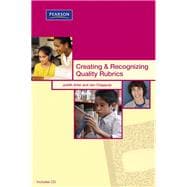
What is included with this book?
Table of Contents
1 Defining Rubric ................................................................. 1
Contexts for Rubrics ..................................................... 3
Helping Teachers................................................................. 3
Helping Students ................................................................. 4
Rubrics as Part of Assessment of and for Learning........... 4
Types of Assessments Requiring Rubrics
and Scoring Guides........................................................ 6
Types of Rubrics............................................................. 6
Comparing Holistic and Analytic Rubrics .......................... 7
Comparing Task-Specifi c and General Rubrics................ 10
When to Use the Various Types of Rubrics ....................14
Learning Targets................................................................ 14
Recommendations for When to Use Each Type
of Rubric........................................................................ 17
Focus on General Rubrics................................................. 24
The Path Ahead: Book Content .....................................26
Summary......................................................................27
2 What a Good Rubric Looks Like .............................. 29
Features of a Good-Quality Rubric ...............................31
Understanding Rubric for Rubrics
Criterion 1: Coverage/Organization ......................... 34
Understanding Rubric for Rubrics
Criterion 2: Clarity ...................................................... 39
Practicing with the Whole Rubric for Rubrics...................43
Rubric for Rubrics Criterion 1:
Coverage/Organization ............................................. 46
Rubric for Rubrics Criterion 2: Clarity ......................... 54
For More Practice.............................................................. 60
Summary......................................................................62
3 How to Develop a General Rubric........................... 65
Rubric Development ....................................................67
Developing a Rubric When the Criteria Are Unclear .....68
Step 1: Choose a Learning Target Worth the Time ......... 68
Step 2: Search out Existing Relevant Scoring
Guides ........................................................................... 68
Step 3: Gather Samples of Student Work......................... 69
Step 4: Sort Student Work ................................................ 69
Step 5: Group Like Indicators Together........................... 73
Step 6: Identify Student Work That Illustrates
Each Level on Each Criterion ...................................... 77
Step 7: Test the Rubric and Revise It as Needed............. 78
Step 8: Repeat the Cycle of Scoring and Revising........... 80
Developing a Rubric When You Already
Have an Idea of the Structure of the Criteria ................81
Developing Student-Friendly Versions............................82
Summary......................................................................84
4 Quality Performance Tasks.......................................... 87
Planning for Task Quality ...............................................90
Determining the Purpose of the Assessment .................. 90
Identifying the Learning Targets to Be Assessed ............ 91
Criteria for Good Tasks .................................................92
Task Quality Criterion 1: Content of the Task ................ 92
Task Quality Criterion 2: Sampling............................... 100
Task Quality Criterion 3: Distortion Due to Bias......... 103
Authenticity and Complexity ...................................... 106
Ensuring Performance Task Quality .............................. 107
Summary.................................................................... 108
5 How to Convert Rubric Scores to Grades...........109
Grading Caveats ......................................................... 111
Caveat 1: Use Grades Only to Communicate ................. 112
Caveat 2: Use Grades Only to Communicate
About Learning ........................................................... 113
Caveat 3: Grades Are Not the Best Way to
Give Students Feedback on Learning........................ 114
Assigning a Grade to a Single Piece of Work
Scored with a Rubric .................................................. 114
Don’t Use Percentages, Use a Logic Rule ...................... 114
How to Weight Rubric Scores ......................................... 120
Determining a Final Grade Across Several
Pieces of Work, All Scored Using a Rubric ................. 122
Combining Rubric Scores with Percentage Scores
to Determine a Final Grade ........................................ 126
Step 1: Average the Ratings on the Rubric
Portion of the Grade................................................... 126
Step 2: Convert to a Logical Percentage ....................... 126
Step 3: Decide on the Weight for Each Portion of
the Grade and Compute the Average Percentage .... 128
Step 4: Convert the Average Percentage to a Grade ..... 128
Summary.................................................................... 129
6 Tasks and Rubrics as Assessment for Learning .....131
Performance Assessments as Episodes of Learning ...... 133
Rubrics as Teaching Tools............................................. 135
Strategy 1: Provide a Clear and Understandable
Vision of the Learning Target..................................... 137
Strategy 2: Use Examples and Models of Strong
and Weak Performances or Products ........................ 138
Strategy 3: Offer Regular Descriptive Feedback ........... 140
Strategy 4: Teach Students to Self-Assess and
Set Goals ..................................................................... 143
Strategy 5: Design Lessons to Focus on One
Aspect of Quality at a Time........................................ 144
Strategy 6: Teach Students Focused Revision............... 144
Strategy 7: Engage Students in Self-Refl ection and
Let Them Keep Track of and Share Their Learning... 145
Summary.................................................................... 146
7 Communicating with Parents about Rubrics ........147
What Rubrics Are and When You Use Them................. 149
How Using Rubrics Benefi ts Learning ............................. 152
How Rubrics Are Used in the Classroom ...................... 153
How to Interpret Rubric Scores ...................................... 154
How Parents Can Use Rubrics with Their Children ...... 155
Suggestions for Sharing Information with Parents.......... 156
When ................................................................................ 156
How .................................................................................. 157
Students’ Role in Communicating with Parents ............ 158
Summary............................................................................. 159
Glossary .............................................................................161
Bibliography .......................................................................165
Appendix A Rubric for Rubrics....................................179
Appendix B R ubric Sampler Table of Contents..........189
Appendix C Rubric Sampler Rubrics
Referenced in the Text ....................................................191
Appendix D Rubric for Tasks ........................................247
Appendix E CD Table of Contents .............................253
The New copy of this book will include any supplemental materials advertised. Please check the title of the book to determine if it should include any access cards, study guides, lab manuals, CDs, etc.
The Used, Rental and eBook copies of this book are not guaranteed to include any supplemental materials. Typically, only the book itself is included. This is true even if the title states it includes any access cards, study guides, lab manuals, CDs, etc.